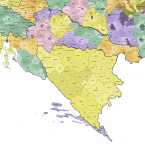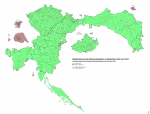Okay, so I've now gone through the Galician results in the official statistics, and I think (emphasis on "think") this is how the electoral system worked there:
- The kingdom is divided into 70 constituencies, of which 34 are urban constituencies electing one member each and the remaining 36 are rural constituencies electing two members each (thus totalling 106 representatives in the Reichsrat for Galicia). For the urban constituencies, the election is carried out under exactly the same system as in the other provinces.
- In the rural constituencies, even though two seats are up for election, the voter only casts a single (non-transferable) vote. This is done in order to prevent the ethnic majority from crowding out the largest minority.
- Once the votes are tallied, if the first-placed candidate has reached 50% of the vote, that person is declared elected.
- If the first-placed candidate reached 50% of the vote and the second-placed candidate reached 25% of the vote, they are both declared elected and the election is complete.
- If the first-placed candidate reached 50% of the vote, but no other candidate reached 25%, there is a runoff between the second- and third-placed candidates to determine who wins the second seat.
- If no candidate reached 50%, the entire election is thrown out and a second round held in which any candidate from the first round may stand again. I don't know if it was possible to nominate candidates for the second round who didn't stand in the first, but my gut says no given that I haven't seen any case where this happened (as far as I've been able to determine - the statistics don't name individual candidates, but do show multiple candidates from the same party separately).
- The win conditions for the second round are the same as in the first round (50% for the first-placed candidate and 25% for the second), but if no one wins 50% this time either, a runoff is held with the top three candidates, of which the top two are declared elected.
Really, this is one of those cases where the word "insane" doesn't quite feel like enough. As mentioned earlier, the object of this system was to provide representation for the ethnic minority in mixed areas, and even the statistical manual explicitly notes that the constituencies where this was relevant tended to be the ones where Ukrainians formed the majority and Poles the minority. So in practice, it wasn't so much that it would be too much of a pain to draw fair constituencies, as it was that the Polish nobles who ran the Galician Diet felt that they deserved to maintain control even though the electoral system no longer favoured them quite as blatantly as the previous one had.




